
Students rewrite the sentences adding missing apostrophes where needed.
- Subject:
- English Language Arts
- Material Type:
- Activity/Lab
- Provider:
- K12 Reader
- Author:
- K12 Reader
- Date Added:
- 02/26/2019

Students rewrite the sentences adding missing apostrophes where needed.

For this online interactive, students read sentences and make their scorpion eat bugs that represent the correct answer for each sentence. Each bug is color coded with answer options. Students use the arrow keys to move their scorpion in the maze to "eat" as many answers as they can.

This instructional video discusses attibutive adjectives and how they are used in sentences. Examples are provided to aid in student understanding.

The students will explore the relationship between purpose, audience, and appropriate language. The students will, also, compose originial emails and letters using appropriate language and word choice
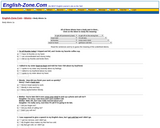
Students will look at each sentence and read the underlined idiom. Next, students select the answer that gives the meaning of the underlined idiom. Students receive immediate feedback after each sentence for their response.
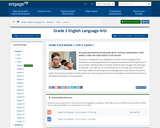
In this lesson from Expeditionary Learning, students will imagine themselves in the role of the main characters of That Book Woman by Heather Henson. They will discover the motivations of the characters through role-playing and investigating the illustrations in the text. Students will use an informational text to investigate why it might be difficult to get books to people, as it was in That Book Woman. This is Lesson 1 of 17 from the Grade 3 Curriculum Map Unit 3, Module 1: http://engageny.org/resource/grade-3-ela-module-1-unit-3 .

Sstudents rewrite a paragraph replacing the word 'good' with a different word.

Students write the comparative form for the adjectives shown.

For this interactive quiz, students complete each sentence by choosing the correct pronoun. Students are able to track the number of correct and incorrect responses. Explanations are provided for incorrect responses.

For this online interactive, students gain an understanding of the concept of conjunctions. This game contains a lesson and four practice games. The lesson explains conjunctions with a definition and examples. The practice game contains questions, like sentence formation using conjunction words and fill in the blanks.
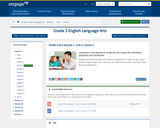
In this lesson from Expeditionary Learning, students will perform a close reading of Thank You, Mr. Falker by Patricia Polacco. They will answer questions using specific details from the text and explain why they chose those details. Students will also use context clues to access new vocabulary. This is Lesson 2 of 10 from the unit Grade 3 Curriculum Map Unit 2, Module 1: http://engageny.org/resource/grade-3-ela-module-1-unit-2 .
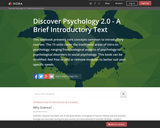
This textbook presents core concepts common to introductory courses. The 15 units cover the traditional areas of intro-to-psychology; ranging from biological aspects of psychology to psychological disorders to social psychology. This book can be modified: feel free to add or remove modules to better suit your specific needs.
This book includes a comprehensive instructor's manual, PowerPoint presentations, a test bank, reading anticipation guides, and adaptive student quizzes.
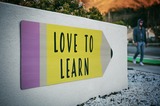
As a way to support teachers with English Language Arts (ELA) instruction during the pandemic, the NCDPI ELA team created choice boards featuring standards-aligned ELA activities.The intended purpose of these choice boards is to provide a way for students to continue standards-based learning while schools are closed. Each activity can be adapted and modified to be completed with or without the use of digital tools. Many activities can also be repeated with different texts. These standards-based activities are meant to be a low-stress approach to reinforcing and enriching the skills learned during the 2019-2020 school year. The choice boards are to be used flexibly by teachers, parents, and students in order to meet the unique needs of each learner.Exploration activities are provided for a more self-directed or guided approach to independent learning for students. These activities and sites should be used as a way to explore concepts, topics, skills, and social and emotional competencies that interest the learner.

The 11th grade learning experience consists of 7 mostly month-long units aligned to the Common Core State Standards, with available course material for teachers and students easily accessible online. Over the course of the year there is a steady progression in text complexity levels, sophistication of writing tasks, speaking and listening activities, and increased opportunities for independent and collaborative work. Rubrics and student models accompany many writing assignments.Throughout the 11th grade year, in addition to the Common Read texts that the whole class reads together, students each select an Independent Reading book and engage with peers in group Book Talks. Students move from learning the class rituals and routines and genre features of argument writing in Unit 11.1 to learning about narrative and informational genres in Unit 11.2: The American Short Story. Teacher resources provide additional materials to support each unit.

In this unit, students will take a look at the historical vision of the American Dream as put together by our Founding Fathers. They will be asked: How, if at all, has this dream changed? Is this dream your dream? First students will participate in an American Dream Convention, acting as a particular historical figure arguing for his or her vision of the American Dream, and then they will write an argument laying out and defending their personal view of what the American Dream should be.
ACCOMPLISHMENTS
Students read and annotate closely one of the documents that they feel expresses the American Dream.
Students participate in an American Dream Convention, acting as a particular historical figure arguing his or her vision of the American Dream.
Students write a paper, taking into consideration the different points of view in the documents read, answering the question “What is the American Dream now?”
Students write their own argument describing and defending their vision of what the American Dream should be.
GUIDING QUESTIONS
These questions are a guide to stimulate thinking, discussion, and writing on the themes and ideas in the unit. For complete and thoughtful answers and for meaningful discussions, students must use evidence based on careful reading of the texts.
What has been the historical vision of the American Dream?
What should the American Dream be? (What should we as individuals and as a nation aspire to?)
How would women, former slaves, and other disenfranchised groups living during the time these documents were written respond to them?
BENCHMARK ASSESSMENT: Cold Read
During this unit, on a day of your choosing, we recommend you administer a Cold Read to assess students’ reading comprehension. For this assessment, students read a text they have never seen before and then respond to multiple-choice and constructed-response questions. The assessment is not included in this course materials.

What is the best way to convince people that you are right? In this lesson, students will look at the structure of the Declaration of Independence, examining how the argument is constructed.

This unit uses William Shakespeare’s Much Ado About Nothing as a vehicle to help students consider how a person is powerless in the face of rumor and how reputations can alter lives, both for good and for ill. They will consider comedy and what makes us laugh. They will see how the standards of beauty and societal views toward women have changed since the Elizabethan Age and reflect on reasons for those changes. As students consider the play, they will write on the passages that inspire and plague them and on topics relating to one of the themes in the play. Finally, they will bring Shakespeare’s words to life in individual performances and in group scene presentations.
ACCOMPLISHMENTS
Students read Shakespeare’s Much Ado About Nothing .
Students read two Shakespearean sonnets and excerpts from an Elizabethan morality handbook dealing with types of women, and they respond to them from several different perspectives.
For each work of literature, students do some writing. They learn to write a sonnet; create a Prompt Book; complete a Dialectical Journal; and write an analytical essay about a topic relating to a theme in the play.
Students see Shakespeare’s play as it was intended to be seen: in a performance. They memorize 15 or more lines from the play and perform them for the class. Students take part in a short scene as either a director or an actor.
GUIDING QUESTIONS
These questions are a guide to stimulate thinking, discussion, and writing on the themes and ideas in the unit. For complete and thoughtful answers and for meaningful discussions, students must use evidence based on careful reading of the texts.
What are society’s expectations with regard to gender roles?
Does humor transcend time? Do we share the same sense of humor as our ancestors?
How do we judge people?
How important is reputation?
BENCHMARK ASSESSMENT (Cold Read)
During this unit, on a day of your choosing, we recommend you administer a Cold Read to assess students’ reading comprehension. For this assessment, students read a text they have never seen before and then respond to multiple-choice and constructed-response questions. The assessment is not included in this course materials.
CLASSROOM FILMS
The Branagh version of Much Ado About Nothing is available on DVD through Netflix and for streaming through Amazon. Other versions are also available on both sites.

The purpose of this second Benchmark Assessment (Cold Write) is to determine what students know about informational writing. Students will respond to a writing prompt, and you will score results as a measure of progress. Following this assessment, students will practice conducting close analysis of various passages from Much Ado About Nothing and continue their character analysis by writing a Perfect Paragraph.

People often say that mankind should learn from history. Charles Dickens, whose books are considered classics, set his novel A Tale of Two Cities in the past. He wanted his readers to learn from the bloody French Revolution and from the widespread brutality in London. Both cities (Paris and London) offer the reader a glimpse into dark and dangerous times. As students read about Dickens's Victorian setting and learn his view of the French Revolution, they will think about what makes a just world. Students will have a chance to think about their own experiences, and, using techniques they have learned from Charles Dickens, they will do some writing that sends a message about your own world.
ACCOMPLISHMENTS
To complete the unit accomplishments, students will:
Read the Charles Dickens novel A Tale of Two Cities.
Read several short pieces, including a biography of Dickens and excerpts from other literature, to help them understand Dickens’s world and the world of the novel.
Explore new vocabulary to build their ability to write and speak using academic language.
Practice close reading and participate in several role plays and dramatic readings to help them experience the dramatic writing style of Charles Dickens.
Write a vignette and a short narrative piece, and practice using descriptive detail and precise language.
Write a reflection about the meaning of Dickens’s novel.
GUIDING QUESTIONS
These questions are a guide to stimulate thinking, discussion, and writing on the themes and ideas in the unit. For complete and thoughtful answers and for meaningful discussions, students must use evidence based on careful reading of the texts.
How does good storytelling affect the reader, and how can a good story promote change in the world?
What was the Victorian view of gender roles?
How can power be abused?
What is loyalty ? What are the limits of loyalty?
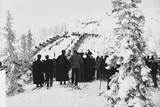
In this lesson, you will talk about the ways in which images send social and political messages to the reader.In this lesson, students will talk about the ways in which images send social and political messages to the reader.